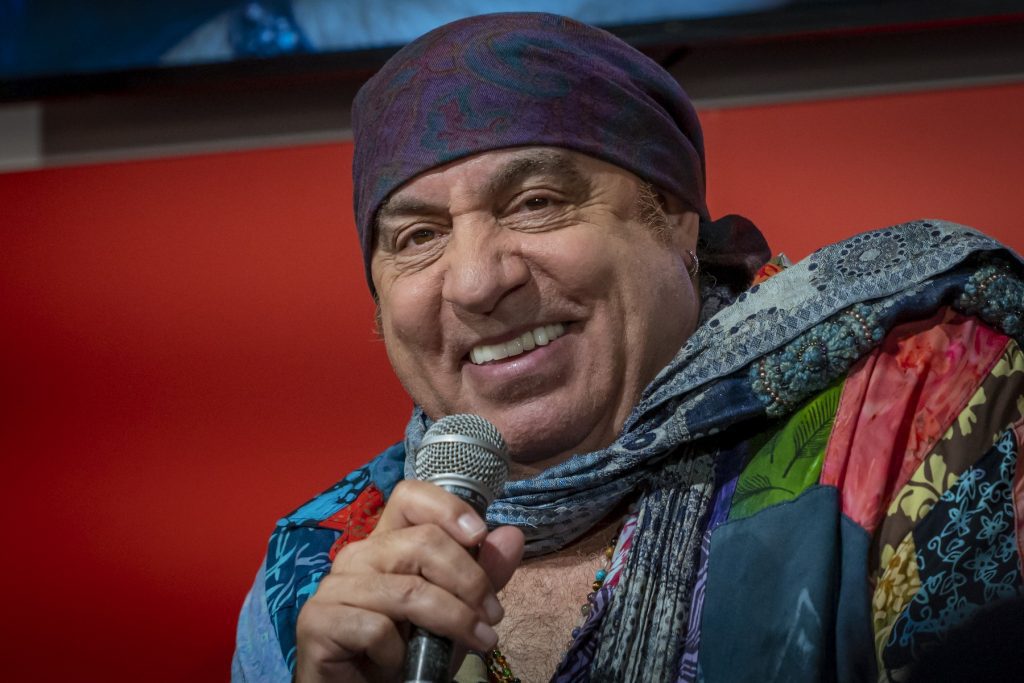
Helado Negro Found Himself by Searching for Joy
Toward the end of Helado Negro’s radiant new album Far In, a song called “Wind Conversations” stands out for its serene simplicity. “Here we are, laying in this shade, deep stay,” he sings over rich, bucolic chords. “Trees shake, ants come to graze.” Lurking in the beauty of the moment is a reminder of how impermanent, fleeting, and vulnerable everything around us is. The song is a few minutes of levity even as the world cascades, inevitably, toward rock bottom. “Strange hell,” he continues. “Sitting here, breathing, knowing it’s too late.”
Across his discography over the years, Helado Negro — whose real name is Roberto Carlos Lange — has built luminous soundscapes that have always been tethered to modern anxieties and the tumult of the current era. His stunning 2016 LP Private Energy broke through to Latinx kids for its honest, open-hearted examination of bicultural identity and brownness in the U.S., explored with a gentle hand and glowing production. His 2018 release, This Is How You Smile, doubled as an electronic masterwork and a manual for self-preservation amid fraught times, employing sounds that soothed and stirred listeners at the same time.
blogherads.adq.push(function () {
blogherads
.defineSlot( ‘medrec’, ‘gpt-dsk-tab-latin-article-inbody1-uid0’ )
.setTargeting( ‘pos’, [“mid”,”mid-article”,”btf”,”in-article1″] )
.setSubAdUnitPath(“music//latin//article//inbody1”)
.addSize([[300,250],[2,2],[3,3]])
;
});
Far In is his first album on the storied U.K. post-punk label 4AD, and it feels like a sonic turn in some ways; it’s teeming with the upbeat energy and dance grooves that are familiar from Lange’s past work, only now they’re at the forefront. “With the last record, a lot of my voice was at the center. What I focused on here was giving more prominence to the drums and bass and giving them an opportunity to shine through, rather than having it be so implied and blurry,” he says on a recent call from Asheville, North Carolina, where he moved this year. “Everything is clearly defined — you can feel the drums and you can kind of see them.”
The project is full of incandescent synths and bright rhythms, all imbued with what feels like the sparkle of a disco ball. Songs such as “Gemini and Leo” and “La Naranja” are some of Lange’s most fluid, sprightly productions — yet it’s hard to escape the context under which the album was made. Lange started working on Far In before This Is How You Smile was finished in 2018, and he was eager to move on to something new. However, the next couple of years meant a relentless tour cycle and non-stop travel, all under the crush of global disasters, ecological devastation, and political uncertainty.
Then the pandemic came. Lange was in Marfa, Texas, working on an art collaboration with his wife, the artist Kristi Sword, and ended up staying there for nearly six months. He was surrounded — and inspired — by the nature around him. Those landscapes are woven into the imagery of a few songs, including “Wind Conversations,” another overwhelming reminder of the fragile state of the world.
“There’s a heaviness that was weighing on me,” Lange says. “In a way, there is a joy in the upbeat-ness that I wanted to express, because I was like, ‘Fuck, we have so much to be grateful for, but it also feels like every day, an opportunity is missed to do better.’”
The weight of the project is buoyed by his production choices — and the collaborative processes behind the music. Lange made a lot of This Is How You Smile alone in his studio in Brooklyn, and he wanted a different approach for Far In. He invited friends to sessions and drew on communal experiences of music-making, including when he joined more than 100 artists in Berlin for 2019’s People Festival. He went back to early influences, turning to music from his childhood in Florida, where he grew up with his parents, who had emigrated from Ecuador. More influences are on a playlist Lange has been sharing with fans and interviewers that features Prince, the British post-disco band iLevel, and the prolific American experimentalist Laraaji.
Laraaji actually had an unintentional hand in project more directly: Lange was sitting in the airport after finishing People Festival when he spotted the 78-year-old musician nearby. He worked up the courage to introduce himself and listened as Laraaji told him about some piano recordings he’d just done. Lange shared stories about the festival and the collaborative work he’d been a part of in Berlin. “I had just had this intense, amazing experience — I’m sure my enthusiasm was shining through my eyeballs,” he remembers. “And he said, ‘Oh, wow, far in.’ Just the way he said it cracked me up. He has a unique way, this humor with a deep profoundness to it all, and it embodies the way he is.”
blogherads.adq.push(function () {
blogherads
.defineSlot( ‘medrec’, ‘gpt-dsk-tab-latin-article-inbody2-uid1’ )
.setTargeting( ‘pos’, [“mid”,”mid-article2″,”btf”,”in-article2″,”mid-article”] )
.setSubAdUnitPath(“music//latin//article//inbody2”)
.addSize([[300,250],[300,251],[2,4],[4,2]])
.setLazyLoadMultiplier(2)
;
});
The expression resonated with Lange, who saw it as a representation of the album’s ethos. “When you find yourself super far in, that’s when you end up expressing yourself in the best way,” he says.
For Lange, being far in has meant finding the strength and confidence, now more than ever, to stay committed to the music he wants to make. “I feel comfortable, I feel good with myself,” he says. “This was the first time I made a record that was a full expression of things that I love and everything that’s a part of me.”




